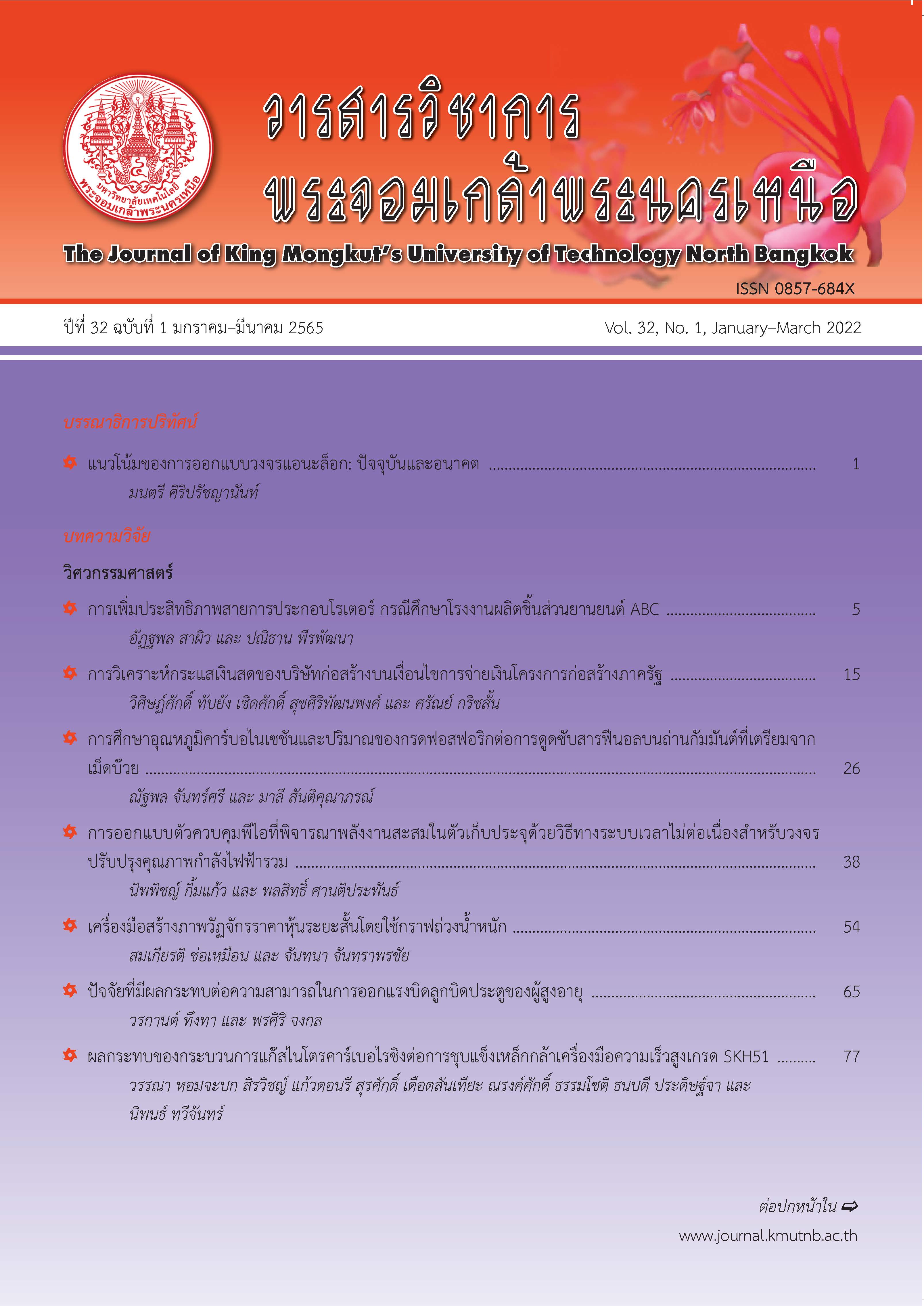ปัจจัยที่มีผลกระทบต่อความสามารถในการออกแรงบิดลูกบิดประตูของผู้สูงอายุ
Main Article Content
บทคัดย่อ
งานวิจัยนี้มีวัตถุประสงค์เพื่อวัดความสามารถในการออกแรงบิดลูกบิดประตูและศึกษาปัจจัยที่มีผลต่อแรงบิดลูกบิดประตูของผู้สูงอายุ งานวิจัยแบ่งเป็น 2 ส่วนคือ ส่วนที่ 1 การสำรวจข้อมูลทั่วไปของผู้ถูกทดสอบ และการวัดสัดส่วนร่างกายของผู้ทดสอบ ส่วนที่ 2 การวัดความสามารถในการออกแรงบิดของผู้สูงอายุ ผู้สูงอายุที่เข้าร่วมในการทดสอบครั้งนี้มีอายุตั้งแต่ 60 ปีขึ้นไป (อายุเฉลี่ย 71.1 ปี ส่วนเบี่ยงเบนมาตรฐานเท่ากับ 7.99) เป็นผู้ที่มีสุขภาพร่างกายแข็งแรงและไม่มีความพิการใดๆ อาศัยอยู่ในจังหวัดนครราชสีมาจำนวนทั้งหมด 108 คน แบ่งเป็นเพศชาย 21 คน และเพศหญิง 87 คน จากการสำรวจผู้สูงอายุทั้งหมดถนัดมือขวา ส่วนใหญ่แล้วจบการศึกษาระดับประถมศึกษาและไม่ได้ประกอบอาชีพ ผลการทดสอบพบว่า ในการออกแรงในท่ายืนของผู้สูงอายุทั้งเพศชายและเพศหญิงนั้น ค่าเฉลี่ยของความสามารถในการออกแรงบิดมีค่ามากที่สุดเมื่อออกแรงด้วยมือขวาที่ระดับความสูง 1,000 มม.และความสามารถในการออกแรงบิดมีค่าน้อยที่สุดเมื่อออกแรงด้วยมือซ้ายที่ระดับความสูง 1,200 มม. ส่วนการออกแรงในท่านั่งของผู้สูงอายุทั้งเพศชายและเพศหญิงนั้นพบว่า ค่าเฉลี่ยของความสามารถในการออกแรงบิดมีค่ามากที่สุดเมื่อออกแรงด้วยมือซ้ายที่ระดับความสูง 1,000 มม.และมีค่าน้อยที่สุดเมื่อออกแรงด้วยมือซ้ายที่ระดับความสูง 1,200 มม. นอกจากนี้ยังพบว่าเพศ ระดับความสูง ข้างของมือที่ออกแรง ทิศในการออกแรง มีผลต่อค่าแรงบิดของผู้สูงอายุอย่างมีนัยสำคัญ (p<0.05)
Article Details
บทความที่ลงตีพิมพ์เป็นข้อคิดเห็นของผู้เขียนเท่านั้น
ผู้เขียนจะต้องเป็นผู้รับผิดชอบต่อผลทางกฎหมายใดๆ ที่อาจเกิดขึ้นจากบทความนั้น
เอกสารอ้างอิง
[2] Ministry Regulations Prescribe the Facilities or Services in the Buildings for Persons with Disabilities and Elderly, Standard 122, 2005 (in Thai).
[3] F. H. Rohles, K. L. Moldrup, and J. E. Laviana, “An anthropometric study of the wrist-twisting strength of the elderly,” in Proceedings of the Human Factors Society, 1983, pp.112–116.
[4] J. O. Crawford, E. Wanibe, and L. Nayak, “The interaction between lid diameter, height and shape on wrist torque exertion in younger and older adults,” in Proceedings of Ergonomics, 2002, pp. 922–933.
[5] S. N. Imrhan and C. H. Loo, “Torque capabilities of the elderly in opening screw top containers,” in Proceedings of the Human Factors Society, 1986, pp. 1167–1171.
[6] A. Mital and S. Kumar, “Human muscle strength definitions, measurement and usage: Part I-guidelines for the practitioner,” International Journal of Industrial Ergonomics, vol. 22, pp. 101–121, 1998.
[7] H. M. Bordett, R. J. Koppa, and J. J. Congelton, “Torque required from elderly females to operate faucet handles of various shapes,” in Proceedings of the Human Factors Society, 1988, pp. 339–346.
[8] P. Axelsson and J. Karrholm, “New methods to assess forearm torque and lifting strength: Reliability and validity,” in Proceedings of Elsevier, 2018, pp. 1–17.
[9] J. Matsuoka, R. A. Berger, L. J. Berglund, and K. N. An, “An analysis of symmetry of torque strength of the forearm under resisted fore arm rotation in normal subjects,” The Journal of Hand Surgery, vol. 31, pp. 801–805, 2006.
[10] L. G. Richards, B. Olson, and P. Thomas, “How forearm position affects grip strength,” American Journal of Occupational Therapy, vol. 50, pp. 133–138, 1996.
[11] W. N. Timm, S. W. O’Driscoll, E. M. Johnson, and K.N. An, “Functional comparison of pronation and supination strengths,” Journal of Hand Therapy, vol. 6, pp. 190–193, 1993.
[12] D. B. Chaffin, G. D. Herrin, W. M. Keyserling, and J. A. Foulke, “Pre-employment strength testing in selecting workers for materials handling jobs” in Proceedings of National Institute for Occupation Safety and Health, 1977.
[13] W. M. Keyserling, G. D. Herrin, and D. B. Chaffin, “An analysis of selected work muscle strengths,” in Proceedings of the Human Factors Society, 1978.
[14] A. Mital and M. M. Ayoub, “Modeling of isometric strength and lifting capacity,” in Proceedings of the Human Factors Society, 1980, pp. 285–290.
[15] A. Mital and I. Manivasagan, “Development of non-linear polynomials in identifying human isometric strength behavior,” International Journal of Computer and Industrial Engineering, vol. 8, no. 1, pp. 1–9, 1984.

